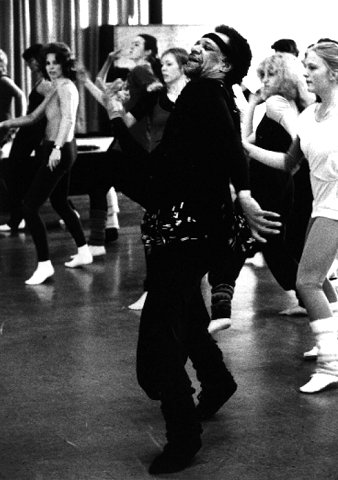Homepage of Nat Horne - Master of Jazz Dance
THE HORNE TECHNIQUE part II
In summary, the Horne Technique is a detailed anatomical approach to jazz dance where isolations (exercises in which the various body parts are each moved separately from the rest of the body in all the ways they might be danced) are executed from deep within the performer and at all times with feeling and in rhythm. In this way the performer's awareness and control of the body is greatly enhanced; and the body's natural relationship to the expression of emotions and the body's natural responsiveness to the rhythms in music are made increasingly accessible.
The Horne Technique also places a great emphasis on the precision in which the isolations are performed. While it is practically impossible to move a part of the body completely isolated from the whole it is a goal that is constantly strived for. As the performer moves closer to that ideal the acuteness of one's awareness and the precision of one's control of the body is greatly increased. The greater the understanding and mastery of the body the richer the palette one has in expressing an increasing variety of emotional colors. This is particularly true in the Horne Technique as all exercises are not performed mechanically but from the very beginning in rhythm and with emotion.
Another particular emphasis of the Horne Technique is the concept of centering. Just as centering is seen as essential in ballet, Nat places a comparable emphasis on centering in jazz but in a manner that both enables the performer to achieve "line" and have all the necessary fluidity for jazz movement. very briefly, the performer stands in a neutral position with their weight forward on the balls of their feet, their heels on the ground, and the weight directed toward the little toe of each foot. The rib cage is pulled up-center and the pelvic bone is aligned under the rib cage. This position enables the performer to find one's center which is, in fact, the solar plexus between rib cage and pelvis. All movements are then seen as emanating out of and returning to center. just. as isolations teach the performer how various body parts function, centering gives a similar awareness and control of how the body moves as an integrated whole. This, of course, becomes increasingly important as combinations and steps are more complex and are executed at faster tempos.
One of the particular advantages of this Technique is its great adaptability not only to -the work of other jazz choreographers but in fact to other dance forms. A number of students have reported that various choreographers have assumed that they had greater training in ballet or modern than they actually had. Another advantage is that when this most free or dance forms in underpinned by a rigorous discipline the performer protects himself very well against injury.
For the performer who primarily is an actor or singer, Nat's Technique not only teaches the performer to move with confidence, grace, and agility but with expressiveness. For the layman, as well as the performer, the Horne Technique is an excellent regimen for the body as it increases stamina, flexibility, and muscle tone. And for the performer, primarily a dancer or not, the heightened awareness and secure control of how the body moves firmly integrated with one's emotional responses to music and the body's innate rhythmic sense maximizes the performer's potential to make of his body a highly developed expressive and artistic instrument.
